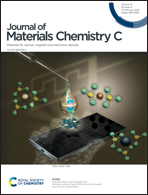Dopant-mediated surface charge imbalance for enhancing the performance of metal oxide chemiresistive gas sensors†
Abstract
Chemically pristine and untailored metal oxide-based gas sensors usually suffer the brunt of poor sensitivity and selectivity. Doping with a suitable element is an efficient strategy to overcome the above challenges. However, to date, the choice of the dopant has been made primarily on empirical basis. This reflects the existence of lack of a general understanding as to what defines the suitability of a dopant. Based on surface electronic state analyses in different cases of dopant-enhanced gas sensing by tin oxide-based systems, we could identify a correlation between the role of the dopant oxidation states for generating surface charge imbalance and improvement in their respective sensing performances. The above studies were then extended to 54 different cases of dopant-induced sensing improvement in metal oxide-based systems and a similar correlation was observed. Based on the above observations, a generalized picture has been drawn that categorically delineates the role of surface charge imbalance in improved gas sensing performance. The above understanding is expected to make the choice of dopant more specific, paving the way for the development of highly sensitive gas sensors.

- This article is part of the themed collections: Journal of Materials Chemistry C Recent Review Articles and Journal of Materials Chemistry C HOT Papers


 Please wait while we load your content...
Please wait while we load your content...